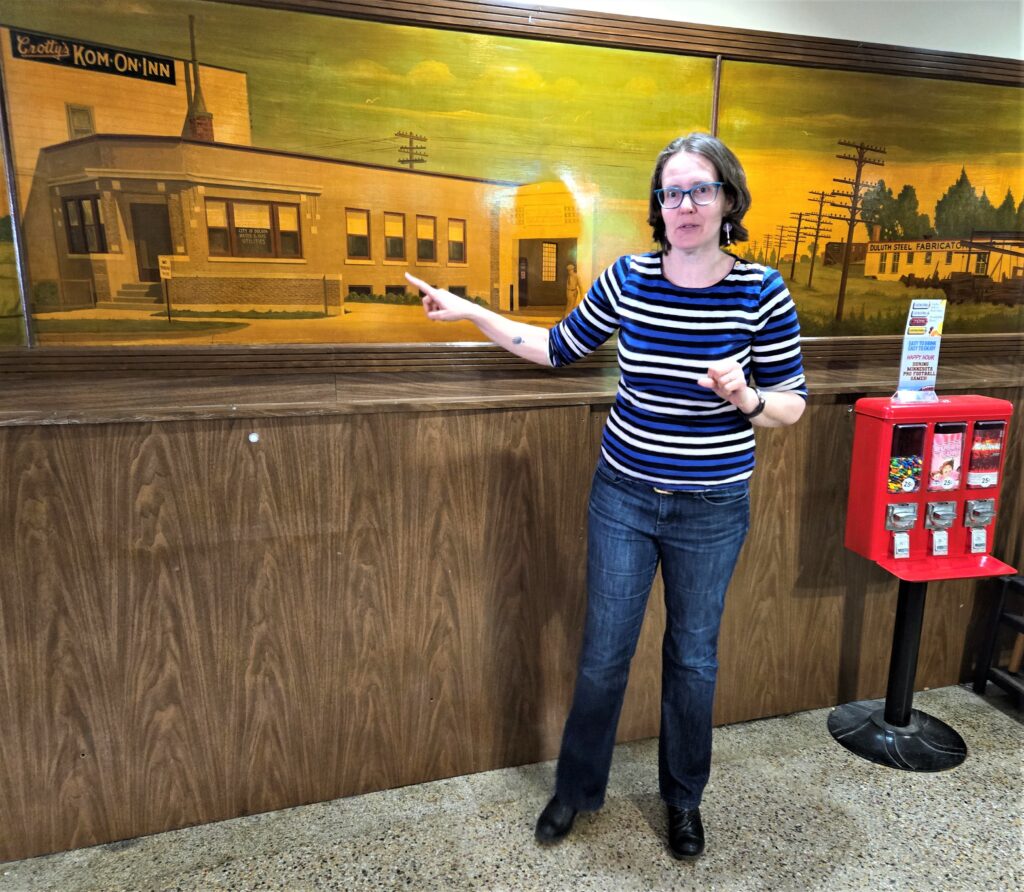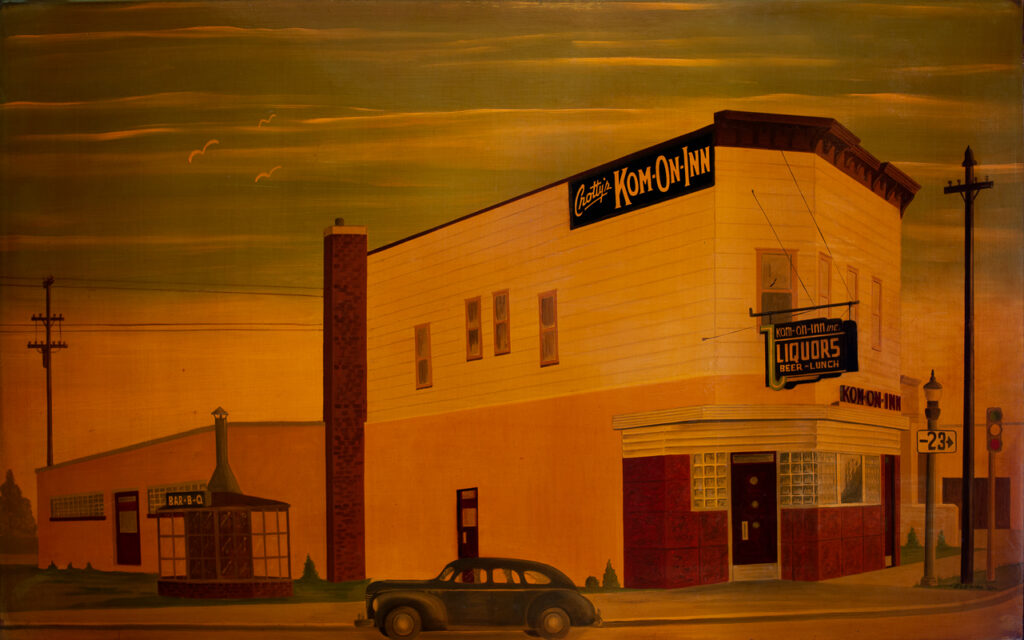
One of the 21 images painted by Art Fleming that line the walls of the Kom-on-Inn in Duluth. This one depicts the U.S. Steel Plant, which has been torn down and is now a Superfund site that is being cleaned up. Note the St. Louis River in the background. The presence of the river emphasizes the role that water has played and continues to play in shaping the city of Duluth. Image credit: Jennifer Webb, University of Minnesota Duluth.
The smell of stale cigarette smoke is the first thing to strike as I walk into the Kom-on-Inn Bar not far from the St. Louis River. Even though indoor smoking in public places was banned 17 years ago in Duluth, Minnesota, the scent lingers here.
It’s 10:30 a.m.; several patrons sit under dim lights at the bar with their beers, chatting. But I’m not here to drink. I’m on a field trip that’s part of the St. Louis River Summit, an annual conference to share information about the largest U.S. tributary that enters Lake Superior on Wisconsin’s northwestern border, and site of the second-largest Area of Concern in the country.
Bars aren’t typical locations for conference field trips. However, this one in West Duluth was chosen for several good reasons. The old paintings that line its walls are one of them. The other reasons involve the bar’s importance to the community.

Art Historian Jennifer Webb describes the community significance of architectural portraits that hang in the Kom-on-Inn Bar in West Duluth, Minnesota. Image credit: Marie Zhuikov, Wisconsin Sea Grant
According to field trip host Jennifer Webb, an art historian and head of the Department of Art and Design at the University of Minnesota Duluth (UMD), 21 paintings are displayed on the bar’s walls, with another 20 stored in the basement.
A resident of this area of Duluth, Webb has studied the artworks for several years and has written a scientific journal article about their significance. Created between 1950-51 by Western Duluth resident and sign painter Art Fleming, these architectural portraits depict local businesses where many of the bar patrons worked. There’s the U.S. Steel mill that made barbed wire and pig iron, the Coolerator Co. that made refrigerators and a coal-fired power plant. A blue strand of the St. Louis River flows through almost every image. The paintings’ varnish coating has yellowed with age and sealed in the cigarette smoke scent.
To Webb, the bar and the portraits epitomize the area. “As an outsider who didn’t grow up in a community like this, the first thing that I was struck by is how every neighborhood has a place, an anchor and an identity.” Bars like the Kom-on-Inn provided a place for workers to gather at the end of their shifts to “decompress from a very difficult and hard industrial life,” she said.
Many of the industries in the paintings closed only two decades after their depiction, leaving unemployment and pollution in their wakes. In Webb’s journal article she says the portraits are a “testament to the pride in place and the importance of the river and industries in the making and then breaking of the neighborhoods and the larger ecosystems of which they are a part.”
Webb suspects that Fleming painted the portraits from photographs since many similar scenes can be found in the photo archives at UMD. The artworks were commissioned by the original bar owners, the Crotty Family, and their preservation is a requirement each time the bar changes hands.
Webb divides us into small groups so that we can take a closer look. In front of one portrait of the river neighborhood of Morgan Park, comprised mainly of homes built by U.S. Steel Co. for their workers, Webb describes the experience she had interviewing people about this painting and their nostalgia for the way of life it depicts.

The Kom-on-Inn panel painted by Art Fleming, located inside the bar. Image credit: Jennifer Webb, University of Minnesota Duluth.
“People who grew up there, when they talk to me about it, they remember their childhood fondly. They had a perfect community. They never really needed to leave. The doctor was there, the dentist. They had a fire department and a hospital,” Webb said. Many of those services are no longer offered directly in Morgan Park.
Plans for remediating Areas of Concern stress the importance of placemaking, which is the process of using public input to create quality places where people will want to live, and broadening the definition of stakeholders. In her paper, Webb argues that such stakeholder groups should include local historians, archivists and art or architectural historians who can offer insights into the built and visual landscape. She also contends that the most successful community revitalization and placemaking work need not create new places but instead should focus on remaking places already formed and to which community members are attached.
“Duluth is so well situated to build walkable communities. We’ve got these anchors like the Kom-on-Inn that were already built as our communities strung themselves out along the waterways. I can’t wait to see where we’re going,” Webb said of restoration efforts.
I left with a new appreciation for this neighborhood where I went to high school, and a broader understanding of the connections between the St. Louis River, its recovery and some paintings in a neighborhood bar.
If you’d like to see the paintings and can’t travel to Duluth, watch this recent television news story about them.


